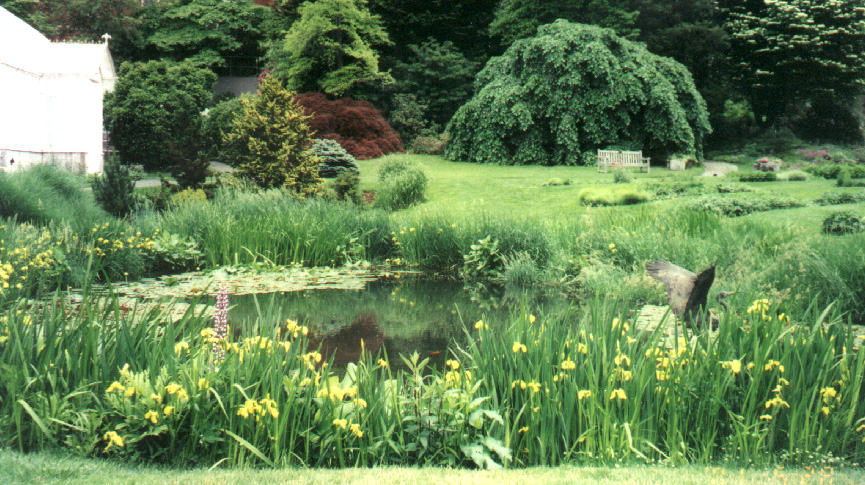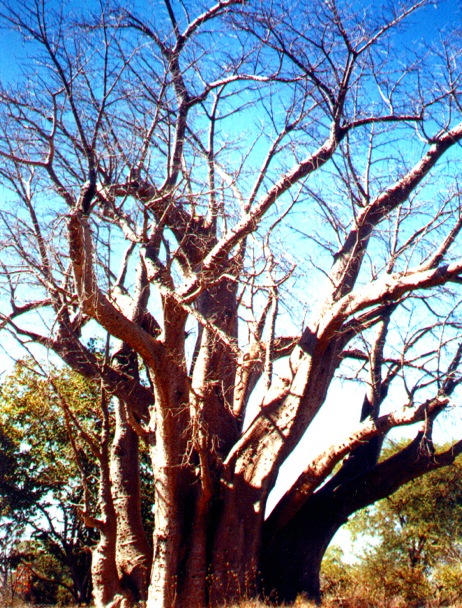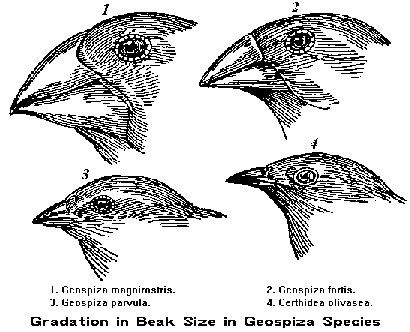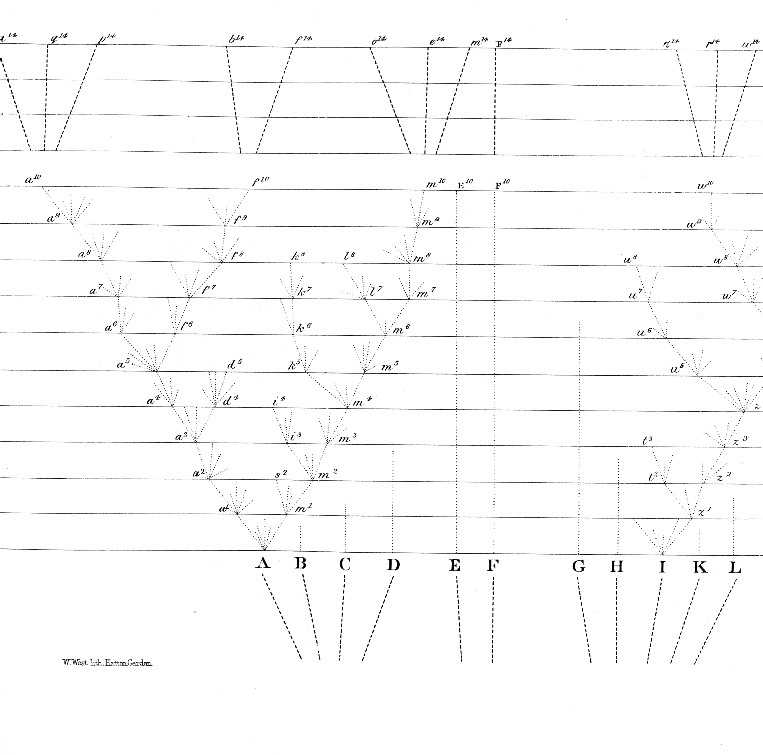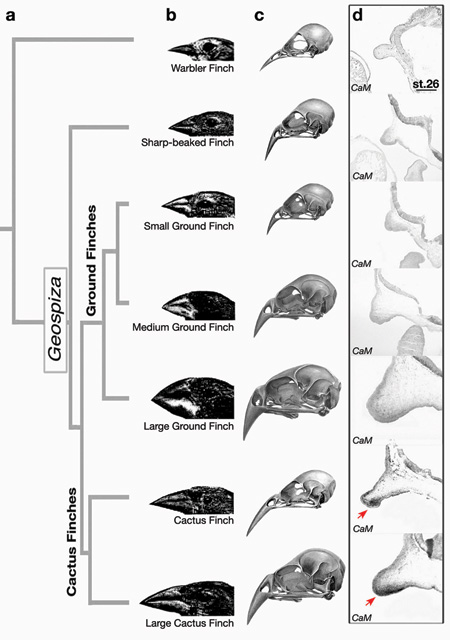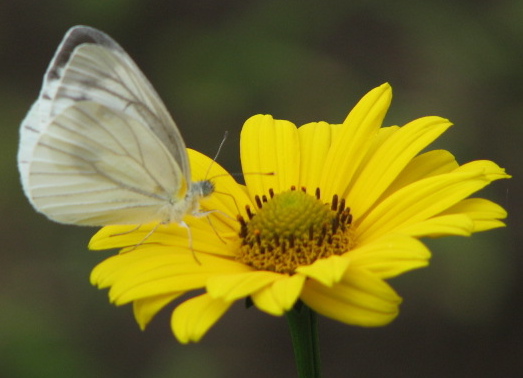Chapter 2:
"It is interesting to contemplate an entangled bank, clothed with many plants of many kinds, with birds singing on the bushes,…"
vocabulary | examples | key concepts | details | summary
Baobab tree, African savanna, Krueger National Park, Union of South Africa, JVS 2002.
It may be convenient to begin an understanding species as each species representing a recent branching from a similar tree, but as you mature the relation of living things to one another is often more like a bush than a tree. That is partially because the branches are entangled.
Remember that life is not only more complex than we think, but may be far more complicated than we can think.
Species are a great example of how humans often misunderstand the world of living creatures. The late Ernst Mayr argues that it took nearly a century since Darwin's Origin of Species to move away from an older ideal of species as a type of creation to our current understanding of reality as a reproductively isolated group with fluid gene flows among reproducing individual members of the population.
Mayr insists that species are not different because of some essential possession–or essence–that differs from all others. He champions this new idea. This he call "population thinking" and it holds that reproductively successful populations that interbreed and maintain similar behavior, niche exploitation, and migratory ranges (animals) are what determine different species.
Vocabulary
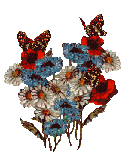 diversity, diversification,
diversity, diversification,
inorganic & organic,
biotic species,
predator – prey relations,
populations,
warblers’ song,
Monarch butterflies,
mimicry,
natural selection,
DDT resistance.
Species (43)
The beaks allow the creature to exploit different diets to survive in their peculiar conditions of the separate islands.
Species is a word and as such “it represents a segment of a continuum and does not have a
clear agreed upon definition (we like ‘distinct kind’ for species, for want of
better [terms]).”
Darwin's conceptual drawing of descent from a common ancestral lineage, or species.
Today DNA and mitochondrial DNA provide valuable evidence (sustaining Darwin's ideas) for the common ancestry of humans and other animals and plants. We understand our descent from common ancestors with Orangutans, Gorillas and Chimpanzees because we share the deoxyribonucleic acid elements with these creature, who are our cousins. This is much the same way plants such as ginger, strelitzia palms and birds of paradise plants share similar stretches of DNA.
Darwin's drawing in the first edition of the Origin of Species. 1859.
What is the relevance of these three important concepts?
√ The conditions under which changes in the environment may and do occur.
√ The means by which inherited characteristics are brought to bear, or fail to cope, with the shifting milieu.
√ The entangled quality of how one species can and often does affect the success of other species.
defining species | speciation due to space | coevolution
| 1. What is a species? | |||
| Darwin's Beagle voyage brought him to South America. The finches (Geospiza) from the Galapagos islands, where Darwin collected these specimens. |
|||
|
|||
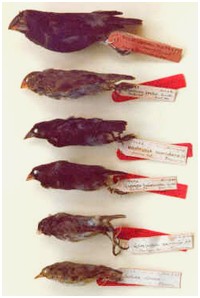 |
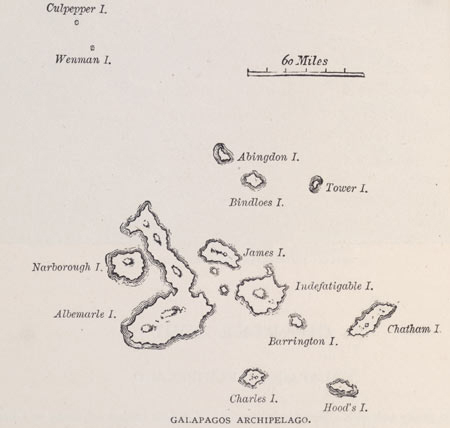 |
||
| ----------------- | ---------------------------------- | ||
“How do the different kinds arise?”
p. 35.
Both physical and behavioral isolation causes variability and the greater the variation the more likely conditions are to separate populations into distinct breeding groups.
“natural selection working on the results of mutation, recombination, migration, and
genetic drift (inherent variability of genomes)
also cause populations to become different from one another forming diverse kinds of organisms.”
p. 36
Examples of separate breeding groups of a population:
 a.
Birds, warblers
a.
Birds, warblers
i. The yellow rumped warblers
ii. “not different enough,” we consider them
all members of the same species.” P. 37
Varieties of Warblers:
Dendroica kirtlandii Kirtland’s warbler sound
Dendroica palmarum Palm warbler sound
Cornell University Ornithology guides on line
b.
“The grand diversity of life” p. 38
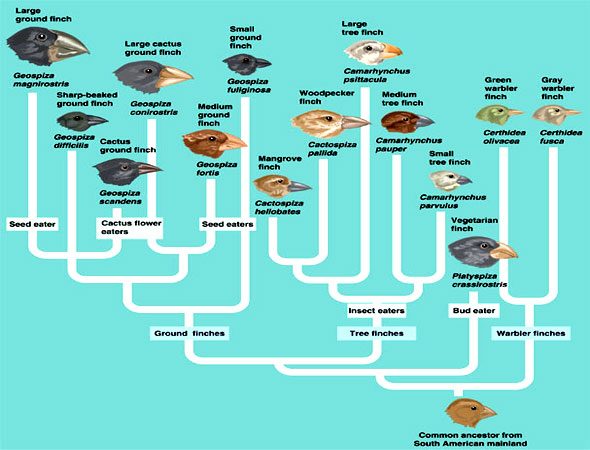
c.
vast changes in several physical conditions of life
gave rise to:
i. Cats (felines) before Pangaea
broke up
1.
Lions, cheetahs, leopards and tigers, snow leopards
2.
jaguars, and panthers, cougars
ii. Trichechus: manatees & dugongs
iii. Monkeys before the fracturing
of Gondwanaland
1.
old world (Africa and Asia = Gondwanaland)
2.
new world (South America = Gondwanaland)
iv. Chimpanzees (climate impacts on hominidae
from pan & pongidae, p. 53)
1.
Forest chimps (display estrus)
2.
Bonobo chimps (suppressed estrus)
“Such
changes in the living environment can be as important to the diversification of
organisms
–to the process of creating new species– as changes in the
physical environment.”
P. 39.
2.
Geographic Speciation, p. 39
a. Swainson’s and hermit thrushes
b. Ernst Mayr’s model of separation due to habitat divisions
c. habitat or living space –called a species' range– is not uniform; niche.
d. creatures can partition a resource that more than one species relies on for food or shelter.
3.
No Species is an Island or Coevolution “the evolutionary interaction of ecologically intimate organisms.”
P. 45.
a. Insects & flowering plants (51)
b. Parasites & hosts (plasmodium falciparum, recall – page 24)
c. Coral reefs & fishes
Details of this chapter
“the grass-grazer and cleaner-predator relationships are
examples of coevolution.” p. 45
“harmless insect mimics.” p. 47
“Monarch
butterfly” p. 48
Evolution is important to comprehend because it affects our relationship to insect pests and antibiotics.
Pesticide resistant insects (we forget coevolution’s lessons),
p. 49
Drug-resistant bacteria,
p. 50
Flowering plants and insects were and remain to this day co-dependent upon one another,
p. 51
Ehrlich offers a "stretched definition" of coevolution (any two –evolving ecosystems)
p. 52
• Technically coevolution refers to the genetic interdependence of two separate species. That is a narrower definition.
• The Ehrlichs offered a broader interpretation to underscore their belief that the community or biological conditions shape the habits and habitations of it members.
In search of nectar the creature gets dusted with pollen of the plant and then spreads the chromosomes of the plant among the other flowers it seeks out for nourishment. This is an example of coevolution.
Bacteria evolve resistance to antibiotics, not unlike pests to pesticides.
"Got cipro?
White oval pills stamped 'Cipro' and '750'The anthrax scare has put an obscure antibiotic, ciprofloxacin, on the front pages. Earlier this week, Manhattan hospital workers became the latest to line up for cipro, as the drug is known on the street.
Anthrax is dangerous, but blanket dosing with antibiotics carries its own risks. We're not talking about side effects, but about the inevitable evolution of bacterial resistance.
Once upon a time, doctors expected antibiotics to extinguish infectious disease, and drug companies essentially quit looking for new antibiotics. The evolution of both bacterium and the AIDS virus, HIV, changed scientists thinking about that. HIV mutates fast enough to evade antiviral drugs.
While HIV is a virus (and not subject to antibiotics), a similar problem exists in the bacterial realm, where antibiotics have served as magic bullets against a host of bacterial diseases, like diphtheria, plague and tuberculosis.
Eventually, bacteria evolve resistance to antibiotics and eventually has arrived. Many nasty bacteria, including members of the Staphylococcus, Enterococcus and Mycobacterium (tuberculosis) families resist multiple drugs.
A natural problem
Resistance is not an accident, but a fact of evolution and chemistry, a logical outcome of the incessant, invisible struggle for existence among microorganisms.
Timetable showing 'years to resistance' for various drugs. Time to resistance is as short as five years.
Bacteria can become resistance to antibiotics in short order.
The creativity of bacteria in adapting to weird environments rests on their rapid multiplication, genetic exchange and frequent genetic errors. Errors, the building blocks for evolution, are "evaluated" by natural selection as an organism faces the demands of survival, and some are so beneficial that they are found in subsequent generations.
These factors explain why bacteria evolve much faster than, say, boa constrictors or duck-billed platypuses. This rapid evolution has produced antibiotic-resistant bacteria that can:
degrade or destroy the antibiotic with enzymes
change target molecules so the drug has nothing to attack
eliminate entry ports on the cell wall/or
pump the antibiotic from the cell
Mechanisms of resistance
Bacteria have two mechanisms for gaining these resistance tricks -- mutation and gene-sharing. A "point mutation" is a change in one base in the DNA molecule. From the bacterium's standpoint, a point mutation is a roll of the dice -- most mutations are harmful; only rarely do these changes give a bug a leg up on the competition.
But with bezillions of bacteria dividing and mutating every second of every day, inevitably some mutations will undermine any antibiotics present. As Charles Darwin might have realized -- resistance is only a matter of time and natural selection.
Translated: Brew a bunch of bacteria in a broth of nutrients, and many will prosper. But once you sprinkle some antibiotic into the cauldron, every bacterium will die -- except any that happen to resist the drug. From that point, through simple heredity, all their offspring are resistant.
Just like that!
Big, fat, white rooster looks off to his right. That simple process is exactly what happens when farm animals are fed low-dose antibiotics to promote growth. A new study found Salmonella bacteria in 20 percent of ground turkey, beef, chicken and pork. Alarmingly, 84 percent of the bugs resisted at least one antibiotic, and 53 percent resisted three or more. The finding sparked renewed calls to control the dosing of farm animals with antibiotics, especially those used by people (see "Isolation of Antibiotic..." in the bibliography below) and our coverage of antibiotics in meat.
Natural resistance
Point mutations probably explain the quick evolution of resistance to cipro, the synthetic antibiotic that is the first line of defense against anthrax.
Cipro inhibits DNA gyrase, an enzyme that twists the double-helix of DNA for compact storage when it's not being duplicated during cell division. Without DNA gyrase, bacteria die -- that's why cipro kills so many types of bacteria. But a point mutation can eliminate cipro's target on the gyrase without inactivating the enzyme.
Because other mechanisms, such as changes in cell wall porosity, can also cause resistance to cipro, total resistance can depend on the total number of defenses.
It makes sense when you think about it, but resistance genes may originate in the same organisms (typically those living in the soil) that made the antibiotic in the first place. Since self-poisoning is an evolutionary dead-end, bugs need protection against their own offense if they make an antibiotic and have the antibiotic's target molecule. Logically, a gene for antibiotic resistance must evolve along with the gene for the antibiotic itself.
Heavy trafficking
While resistance can arise from point mutations, scientists have in recent years found a far more efficient route -- the bacterial swap-meet. While we wouldn't think of sharing our genes with, say, a naked mole rat or China-White hog, bacteria turn out to be surprisingly generous about donating genes -- even to different species. These traveling genes can carry resistance to multiple antibiotics.
The deadly mechanisms for moving genes include movement of DNA on:
- viruses that extract DNA from one bacterium and insert it into others
- fragments of chromosomes released by dead bacteria that are taken up by others
- ring-shaped structures called plasmids
Plasmids: Rings of DNA move from one bacterium to another; free DNA: a bacterium breaks apart, releasing DNA that is taken up by the recipient; viruses: a virus moves DNA between bacteria.
Bacteria transfer resistance to antibiotics through three separate mechanism: plasmids, free DNA, and viruses."
See: http://whyfiles.org/shorties/090antibio_resist/
![]()
Summary
Speciation is a central problem searching for a biological solution, but biogeographically speaking creatures are different due to isolated breeding populations.
Populations vary because their particular mixture of chromosomes inherited directly from their parents and indirectly from their respective ancestral lines differ. Then with crossover during reduction division each individual offspring is slightly dissimilar from its siblings.
Populations change, individuals do not change, unless they are bacterial forms of life.
Despite the assumption that species are made up of breeding individuals, often living creatures are composites of bacteria and either fungus (lichens), plants (legumes), or animals.
Evolution, or changes in breeding populations over time is often accompanied by coevolution of predator and prey populations such that the genetic future of one species is interdependent on another, such as pollinators and flowering plants.
